Urban Sprawl Simulation Mapping of Urmia (Iran) by Comparison of Cellular Automata–Markov Chain and Artificial Neural Network (ANN) Modeling Approach
Abstract
1. Introduction
2. Materials and Methods
2.1. Study Area
2.2. Data and Methods
2.3. Methodology
2.3.1. CA–Markov
2.3.2. Artificial Neural Network
2.3.3. Model Assessment
3. Results
4. Discussion
5. Conclusions
Author Contributions
Funding
Institutional Review Board Statement
Informed Consent Statement
Data Availability Statement
Conflicts of Interest
References
- Bebbington, J. Sustainable development: A review of the international development, business and accounting literature. In Accounting Forum; Taylor & Francis: Oxfordshire, UK, 2001. [Google Scholar]
- Budd, W.; Lovrich, N.; Pierce, J.C.; Chamberlain, B. Cultural sources of variations in US urban sustainability attributes. Cities 2008, 25, 257–267. [Google Scholar] [CrossRef]
- Bovet, J.; Reese, M.; Köck, W. Taming expansive land use dynamics—Sustainable land use regulation and urban sprawl in a comparative perspective. Land Use Policy 2018, 77, 837–845. [Google Scholar] [CrossRef]
- Hassan, A.M.; Lee, H. Toward the sustainable development of urban areas: An overview of global trends in trials and policies. Land Use Policy 2015, 48, 199–212. [Google Scholar] [CrossRef]
- Rubiera-Morollón, F.; Garrido-Yserte, R. Recent Literature about Urban Sprawl: A Renewed Relevance of the Phenomenon from the Perspective of Environmental Sustainability. Sustainability 2020, 12, 6551. [Google Scholar] [CrossRef]
- Coq-Huelva, D.; Asián-Chaves, R. Urban Sprawl and Sustainable Urban Policies. A Review of the Cases of Lima, Mexico City and Santiago de Chile. Sustainability 2019, 11, 5835. [Google Scholar] [CrossRef]
- Artmann, M.; Inostroza, L.; Fan, P. Urban sprawl, compact urban development and green cities. How much do we know, how much do we agree? Ecol. Indic. 2018, 96, 3–9. [Google Scholar] [CrossRef]
- Shao, Z.; Sumari, N.S.; Portnov, A.; Ujoh, F.; Musakwa, W.; Mandela, P.J. Urban sprawl and its impact on sustainable urban development: A combination of remote sensing and social media data. Geospat. Inf. Sci. 2020, 24, 241–255. [Google Scholar] [CrossRef]
- Næss, P. Central dimensions in a sustainable urban development. Sustain. Dev. 1995, 3, 120–129. [Google Scholar] [CrossRef]
- Mansouri Daneshvar, M.R.; Rabbani, G.; Shirvani, S. Assessment of urban sprawl effects on regional climate change using a hybrid model of factor analysis and analytical network process in the Mashhad city, Iran. Environ. Syst. Res. 2019, 8, 1–12. [Google Scholar]
- Aliyu, A.A.; Amadu, L. Urbanization, cities, and health: The challenges to Nigeria—A review. Ann. Afr. Med. 2017, 16, 149. [Google Scholar] [CrossRef]
- Vani, M.; Prasad, P.R.C. Assessment of spatio-temporal changes in land use and land cover, urban sprawl, and land surface temperature in and around Vijayawada city, India. Environ. Dev. Sustain. 2020, 22, 3079–3095. [Google Scholar] [CrossRef]
- Henderson, V. Urbanization in developing countries. World Bank Res. Obs. 2002, 17, 89–112. [Google Scholar] [CrossRef]
- Hatab, A.A.; Cavinato, M.E.R.; Lindemer, A.; Lagerkvist, C.J. Urban sprawl, food security and agricultural systems in developing countries: A systematic review of the literature. Cities 2019, 94, 129–142. [Google Scholar] [CrossRef]
- Nijhoff, M. Urbanization in Developing Countries; Springer: Cham, Switzerland, 2013. [Google Scholar]
- Bonan, G.B. Forests and climate change: Forcings, feedbacks, and the climate benefits of forests. Science 2008, 320, 1444–1449. [Google Scholar] [CrossRef] [PubMed]
- Pflugmacher, D.; Rabe, A.; Peters, M.; Hostert, P. Mapping pan-European land cover using Landsat spectral-temporal metrics and the European LUCAS survey. Remote Sens. Environ. 2019, 221, 583–595. [Google Scholar] [CrossRef]
- Anderson, K.; Ryan, B.; Sonntag, W.; Kavvada, A.; Friedl, L. Earth observation in service of the 2030 Agenda for Sustainable Development. Geo-spat. Inf. Sci. 2017, 20, 77–96. [Google Scholar] [CrossRef]
- Feddema, J.J.; Oleson, K.W.; Bonan, G.B.; Mearns, L.O.; Buja, L.E.; Meehl, G.A.; Washington, W.M. The Importance of Land-Cover Change in Simulating Future Climates. Science 2005, 310, 1674–1678. [Google Scholar] [CrossRef] [PubMed]
- Liu, J.; Liu, M.; Tian, H.; Zhuang, D.; Zhang, Z.; Zhang, W.; Tang, X.; Deng, X. Spatial and temporal patterns of China’s cropland during 1990–2000: An analysis based on Landsat TM data. Remote Sens. Environ. 2005, 98, 442–456. [Google Scholar] [CrossRef]
- Luo, G.; Zhou, C.; Chen, X. Process of land use/land cover change in the oasis of arid region. Acta Geogr. Sin. Chin. Ed. 2003, 58, 63–72. [Google Scholar]
- Maleki, M.; Van Genderen, J.L.; Tavakkoli-Sabour, S.M.; Saleh, S.S.; Babaee, E. Land use/cover change in Dinevar rural area of West Iran during 2000–2018 and its prediction for 2024 and 2030. Geomatics Appl. Geogr. 2020, 15, 93–105. [Google Scholar] [CrossRef]
- Tang, J.; Li, Y.; Cui, S.; Xu, L.; Ding, S.; Nie, W. Linking land-use change, landscape patterns, and ecosystem services in a coastal watershed of southeastern China. Glob. Ecol. Conserv. 2020, 23, e01177. [Google Scholar] [CrossRef]
- Wang, X.; Zheng, Y.; Li, S. Analysis of land use and landscape pattern change in west of Hainan Island. J. Desert Res. 2006, 26, 409–414. [Google Scholar]
- Abuelaish, B.; Olmedo, M.T.C. Scenario of land use and land cover change in the Gaza Strip using remote sensing and GIS models. Arab. J. Geosci. 2016, 9, 274. [Google Scholar] [CrossRef]
- Islam, K.; Jashimuddin, M.; Nath, B.; Nath, T.K. Land use classification and change detection by using multi-temporal remotely sensed imagery: The case of Chunati wildlife sanctuary, Bangladesh. Egypt. J. Remote. Sens. Space Sci. 2018, 21, 37–47. [Google Scholar] [CrossRef]
- Subedi, P.; Subedi, K.; Thapa, B. Application of a hybrid cellular automaton–markov (ca-markov) model in land-use change prediction: A case study of saddle creek drainage basin, Florida. Appl. Ecol. Environ. Sci. 2013, 1, 126–132. [Google Scholar] [CrossRef]
- Pindozzi, S.; Cervelli, E.; Recchi, P.F.; Capolupo, A.; Boccia, L. Predicting land use change on a broad area: Dyna-CLUE model application to the Litorale Domizio-Agro Aversano (Campania, South Italy). J. Agric. Eng. 2017, 48, 27. [Google Scholar] [CrossRef]
- Turner, B.L.; Lambin, E.F., II; Reenberg, A. The emergence of land change science for global environmental change and sustainability. Proc. Natl. Acad. Sci. USA 2007, 104, 20666–20671. [Google Scholar] [CrossRef]
- Foley, J.A.; DeFries, R.; Asner, G.P.; Barford, C.; Bonan, G.; Carpenter, S.R.; Chapin, F.S.; Coe, M.T.; Daily, G.C.; Gibbs, H.K.; et al. Global consequences of land use. Science 2005, 309, 570–574. [Google Scholar] [CrossRef] [PubMed]
- Hamad, R.; Balzter, H.; Kolo, K. Predicting Land Use/Land Cover Changes Using a CA-Markov Model under Two Different Scenarios. Sustainability 2018, 10, 3421. [Google Scholar] [CrossRef]
- Roy, S.; Farzana, K.; Papia, M.; Hasan, M. Monitoring and prediction of land use/land cover change using the integration of Markov chain model and cellular automation in the Southeastern Tertiary Hilly Area of Bangladesh. Int. J. Sci. Basic Appl. Res. 2015, 24, 125–148. [Google Scholar]
- de Almeida, A.S.; Vieira, I.C.G.; Ferraz, S.F.B. Long-term assessment of oil palm expansion and landscape change in the eastern Brazilian Amazon. Land Use Policy 2020, 90, 104321. [Google Scholar] [CrossRef]
- Aghimien, D.O.; Aigbavboa, C.; Edwards, D.J.; Mahamadu, A.-M.; Olomolaiye, P.; Nash, H.; Onyia, M. A fuzzy synthetic evaluation of the challenges of smart city development in developing countries. Smart Sustain. Built Environ. 2020, 11, 405–421. [Google Scholar] [CrossRef]
- Bawa, M.; Cagáňová, D.; Szilva, I.; Spirkova, D. Importance of Internet of Things and Big Data in Building Smart City and What Would Be Its Challenges; Springer: Cham, Switzerland, 2016; pp. 605–616. [Google Scholar] [CrossRef]
- Komolafe, A.A.; Awe, B.S.; Olorunfemi, I.E.; Oguntunde, P.G. Modelling flood-prone area and vulnerability using integration of multi-criteria analysis and HAND model in the Ogun River Basin, Nigeria. Hydrol. Sci. J. 2020, 65, 1766–1783. [Google Scholar] [CrossRef]
- Jat, M.K.; Choudhary, M.; Saxena, A. Application of geo-spatial techniques and cellular automata for modelling urban growth of a heterogeneous urban fringe. Egypt. J. Remote Sens. Space Sci. 2017, 20, 223–241. [Google Scholar] [CrossRef]
- Tadese, M.; Kumar, L.; Koech, R.; Kogo, B.K. Mapping of land-use/land-cover changes and its dynamics in Awash River Basin using remote sensing and GIS. Remote Sens. Appl. Soc. Environ. 2020, 19, 100352. [Google Scholar] [CrossRef]
- Nugroho, F.; Al-Sanjary, O.I. A Review of Simulation Urban Growth Model. Int. J. Eng. Technol. 2018, 7, 17–23. [Google Scholar] [CrossRef]
- Otuoze, S.; Hunt, D.; Jefferson, I. Neural Network Approach to Modelling Transport System Resilience for Major Cities: Case Studies of Lagos and Kano (Nigeria). Sustainability 2021, 13, 1371. [Google Scholar] [CrossRef]
- Dutta, D.; Rahman, A.; Paul, S.K.; Kundu, A. Estimating urban growth in peri-urban areas and its interrelationships with built-up density using earth observation datasets. Ann. Reg. Sci. 2020, 65, 67–82. [Google Scholar] [CrossRef]
- Mansour, S.; Al-Belushi, M.; Al-Awadhi, T. Monitoring land use and land cover changes in the mountainous cities of Oman using GIS and CA-Markov modelling techniques. Land Use Policy 2020, 91, 104414. [Google Scholar] [CrossRef]
- Hale, C. Economic marginalization, social exclusion, and crime. In Criminology; Oxford University Press: Oxford, UK, 2013; pp. 289–307. [Google Scholar]
- Nayak, P.K.; Oliveira, L.E.; Berkes, F. Resource degradation, marginalization, and poverty in small-scale fisheries: Threats to social-ecological resilience in India and Brazil. Ecol. Soc. 2014, 19. [Google Scholar] [CrossRef]
- Foody, G.M. Status of land cover classification accuracy assessment. Remote Sens. Environ. 2002, 80, 185–201. [Google Scholar] [CrossRef]
- Green, K.; Kempka, D.; Lackey, L. Using remote sensing to detect and monitor land-cover and land-use change. Photogramm. Eng. Remote Sens. 1994, 60, 331–337. [Google Scholar]
- Hütt, C.; Koppe, W.; Miao, Y.; Bareth, G. Best Accuracy Land Use/Land Cover (LULC) Classification to Derive Crop Types Using Multitemporal, Multisensor, and Multi-Polarization SAR Satellite Images. Remote Sens. 2016, 8, 684. [Google Scholar] [CrossRef]
- Duan, Y.; Wang, X.; Wei, Y. Land use change analysis of Daishan Island using multi-temporal remote sensing imagery. Arab. J. Geosci. 2020, 13, 741. [Google Scholar] [CrossRef]
- Keshtkar, H.; Voigt, W.; Alizadeh, E. Land-cover classification and analysis of change using machine-learning classifiers and multi-temporal remote sensing imagery. Arab. J. Geosci. 2017, 10, 154. [Google Scholar] [CrossRef]
- Kolli, M.; Opp, C.; Karthe, D.; Groll, M. Mapping of Major Land-Use Changes in the Kolleru Lake Freshwater Ecosystem by Using Landsat Satellite Images in Google Earth Engine. Water 2020, 12, 2493. [Google Scholar] [CrossRef]
- Dadashpoor, H.; Salarian, F. Urban sprawl on natural lands: Analyzing and predicting the trend of land use changes and sprawl in Mazandaran city region, Iran. Environ. Dev. Sustain. 2018, 22, 593–614. [Google Scholar] [CrossRef]
- Mc Cutchan, M.; Özdal-Oktay, S.; Giannopoulos, I. Semantic-based urban growth prediction. Trans. GIS 2020, 24, 1482–1503. [Google Scholar] [CrossRef]
- Veldkamp, A.; Lambin, E.F. Predicting land-use change. Agric. Ecosyst. Environ. 2001, 85, 1–6. [Google Scholar] [CrossRef]
- Mishra, V.N.; Rai, P.K. A remote sensing aided multi-layer perceptron-Markov chain analysis for land use and land cover change prediction in Patna district (Bihar), India. Arab. J. Geosci. 2016, 9, 249. [Google Scholar] [CrossRef]
- Arsanjani, J.J.; Helbich, M.; Kainz, W.; Boloorani, A.D. Integration of logistic regression, Markov chain and cellular automata models to simulate urban expansion. Int. J. Appl. Earth Obs. Geoinform. 2013, 21, 265–275. [Google Scholar] [CrossRef]
- Mustafa, A.; Ebaid, A.; Omrani, H.; McPhearson, T. A multi-objective Markov Chain Monte Carlo cellular automata model: Simulating multi-density urban expansion in NYC. Comput. Environ. Urban Syst. 2021, 87, 101602. [Google Scholar] [CrossRef]
- Kisamba, F.C.; Li, F. Analysis and modelling urban growth of Dodoma urban district in Tanzania using an integrated CA–Markov model. GeoJournal 2022, 1–22. [Google Scholar] [CrossRef]
- Buya, S.; Tongkumchum, P.; Owusu, B.E. Modelling of land-use change in Thailand using binary logistic regression and multinomial logistic regression. Arab. J. Geosci. 2020, 13, 437. [Google Scholar] [CrossRef]
- Tayyebi, A.R.; Yazdanpanah, M.J.; Pijanowski, B.C.; Saeedi, S.; Tayyebi, A.H. A spatial logistic regression model for simulating land use patterns: A case study of the Shiraz Metropolitan area of Iran. In Advances in Earth Observation of Global Change; Springer: Dordrecht, The Netherlands, 2010; pp. 27–42. [Google Scholar]
- Munthali, M.; Mustak, S.; Adeola, A.; Botai, J.; Singh, S.; Davis, N. Modelling land use and land cover dynamics of Dedza district of Malawi using hybrid Cellular Automata and Markov model. Remote Sens. Appl. Soc. Environ. 2019, 17, 100276. [Google Scholar] [CrossRef]
- Wang, X.; Li, J.; Zheng, T.; Diao, S.; Zhang, X.; Tian, Y. Constructing Landscape Ecological Security Patterns of an Ancient Capital Based on Cellular Automata Theory. Urban Sci. 2022, 6, 29. [Google Scholar] [CrossRef]
- Jantz, A.C.; Goetz, S.J.; Shelley, M.K. Using the Sleuth Urban Growth Model to Simulate the Impacts of Future Policy Scenarios on Urban Land Use in the Baltimore-Washington Metropolitan Area. Environ. Plan. B Plan. Des. 2004, 31, 251–271. [Google Scholar] [CrossRef]
- Saxena, A.; Jat, M.K. Capturing heterogeneous urban growth using SLEUTH model. Remote Sens. Appl. Soc. Environ. 2019, 13, 426–434. [Google Scholar] [CrossRef]
- Al Rifat, S.A.; Liu, W. Predicting future urban growth scenarios and potential urban flood exposure using Artificial Neural Network-Markov Chain model in Miami Metropolitan Area. Land Use Policy 2022, 114, 105994. [Google Scholar] [CrossRef]
- Kim, K.-D.; Lee, S.; Oh, H.-J. Prediction of ground subsidence in Samcheok City, Korea using artificial neural networks and GIS. Environ. Earth Sci. 2009, 58, 61–70. [Google Scholar] [CrossRef]
- Chen, Y.; Huang, L. Modeling growth curve of fractal dimension of urban form of Beijing. Phys. A Stat. Mech. Its Appl. 2019, 523, 1038–1056. [Google Scholar] [CrossRef]
- Chen, Y.-G. Logistic models of fractal dimension growth of urban morphology. Fractals 2018, 26, 1850033. [Google Scholar] [CrossRef]
- Baqa, M.; Chen, F.; Lu, L.; Qureshi, S.; Tariq, A.; Wang, S.; Jing, L.; Hamza, S.; Li, Q. Monitoring and Modeling the Patterns and Trends of Urban Growth Using Urban Sprawl Matrix and CA-Markov Model: A Case Study of Karachi, Pakistan. Land 2021, 10, 700. [Google Scholar] [CrossRef]
- Mondal, M.S.; Sharma, N.; Garg, P.K.; Kappas, M. Statistical independence test and validation of CA Markov land use land cover (LULC) prediction results. Egypt. J. Remote Sens. Space Sci. 2016, 19, 259–272. [Google Scholar] [CrossRef]
- Yi, S.; Zhou, Y.; Li, Q. A New Perspective for Urban Development Boundary Delineation Based on the MCR Model and CA-Markov Model. Land 2022, 11, 401. [Google Scholar] [CrossRef]
- Zhou, L.; Dang, X.; Sun, Q.; Wang, S. Multi-scenario simulation of urban land change in Shanghai by random forest and CA-Markov model. Sustain. Cities Soc. 2020, 55, 102045. [Google Scholar] [CrossRef]
- Girma, R.; Fürst, C.; Moges, A. Land use land cover change modeling by integrating artificial neural network with cellular Automata-Markov chain model in Gidabo river basin, main Ethiopian rift. Environ. Challenges 2022, 6, 106034. [Google Scholar] [CrossRef]
- Malik, A.; Bhagwat, A. Modelling groundwater level fluctuations in urban areas using artificial neural network. Groundw. Sustain. Dev. 2021, 12, 100484. [Google Scholar] [CrossRef]
- Naghadehi, S.Z.; Asadi, M.; Maleki, M.; Tavakkoli-Sabour, S.-M.; Van Genderen, J.; Saleh, S.-S. Prediction of Urban Area Expansion with Implementation of MLC, SAM and SVMs’ Classifiers Incorporating Artificial Neural Network Using Landsat Data. ISPRS Int. J. Geo-Inf. 2021, 10, 513. [Google Scholar] [CrossRef]
- Wang, Y.; Sha, Z.; Tan, X.; Lan, H.; Liu, X.; Rao, J. Modeling urban growth by coupling localized spatio-temporal association analysis and binary logistic regression. Comput. Environ. Urban Syst. 2020, 81, 101482. [Google Scholar] [CrossRef]
- Xu, E.; Chen, Y. Modeling Intersecting Processes of Wetland Shrinkage and Urban Expansion by a Time-Varying Methodology. Sustainability 2019, 11, 4953. [Google Scholar] [CrossRef]
- Kaviari, F.; Mesgari, M.S.; Seidi, E.; Motieyan, H. Simulation of urban growth using agent-based modeling and game theory with different temporal resolutions. Cities 2019, 95, 102387. [Google Scholar] [CrossRef]
- Xu, T.; Gao, J.; Coco, G.; Wang, S. Urban expansion in Auckland, New Zealand: A GIS simulation via an intelligent self-adapting multiscale agent-based model. Int. J. Geogr. Inf. Sci. 2020, 34, 2136–2159. [Google Scholar] [CrossRef]
- Yatoo, S.A.; Sahu, P.; Kalubarme, M.H.; Kansara, B.B. Monitoring land use changes and its future prospects using cellular automata simulation and artificial neural network for Ahmedabad city, India. GeoJournal 2020, 87, 765–786. [Google Scholar] [CrossRef]
- Khaledi, S.; Ghahroodi, T.M. Measuring and evaluating the resilience of urban areas against urban flooding (Case study: Urmia City). Sustain. Develop. Geograph. Environ. 2019, 2, 169–182. [Google Scholar] [CrossRef]
- Chitsazan, M.; Aghazadeh, N.; Mirzaee, Y.; Golestan, Y. Hydrochemical characteristics and the impact of anthropogenic activity on groundwater quality in suburban area of Urmia city, Iran. Environ. Dev. Sustain. 2019, 21, 331–351. [Google Scholar] [CrossRef]
- Abedini, A.; Khalili, A.; Asadi, N. Urban Sprawl Evaluation Using Landscape Metrics and Black-and-White Hypothesis (Case Study: Urmia City). J. Indian Soc. Remote Sens. 2020, 48, 1021–1034. [Google Scholar] [CrossRef]
- Abedini, A.; Khalili, A. Determining the capacity infill development in growing metropolitans: A case study of Urmia city. J. Urban Manag. 2019, 8, 316–327. [Google Scholar] [CrossRef]
- Gharakhanlou, N.M.; Hooshangi, N. Spatio-temporal simulation of the novel coronavirus (COVID-19) outbreak using the agent-based modeling approach (case study: Urmia, Iran). Informatics Med. Unlocked 2020, 20, 100403. [Google Scholar] [CrossRef]
- Khedmatzadeh, A.; Mousavi, M.N.; Torkamani, H.M. An Analysis on Land Use Process Changes and Forecasting in Urmia City Using SVM Model and Neural Networks. J. Remote Sens. Gis 2021, 12, 53–72. [Google Scholar] [CrossRef]
- Mohammadi, A.; Ghassoun, Y.; Löwner, M.-O.; Behmanesh, M.; Faraji, M.; Nemati, S.; Toolabi, A.; Abdolahnejad, A.; Panahi, H.; Heydari, H.; et al. Spatial analysis and risk assessment of urban BTEX compounds in Urmia, Iran. Chemosphere 2020, 246, 125769. [Google Scholar] [CrossRef] [PubMed]
- Abedini, A. Measurement of Urban Sprawl Using Spatial-temporal Data (Case Study: City of Urmia). Motaleate Shahri 2018, 7, 63–76. [Google Scholar]
- Abedini, A.; Mosayebzade, A.; Shokrani, M. Urban Physical Development of Urmia City by Quantitative Models. Hum. Geogr. Res. 2015, 47, 411–422. [Google Scholar]
- Takada, T.; Miyamoto, A.; Hasegawa, S.F. Derivation of a yearly transition probability matrix for land-use dynamics and its applications. Landsc. Ecol. 2010, 25, 561–572. [Google Scholar] [CrossRef]
- Nath, B.; Niu, Z.; Singh, R.P. Land Use and Land Cover Changes, and Environment and Risk Evaluation of Dujiangyan City (SW China) Using Remote Sensing and GIS Techniques. Sustainability 2018, 10, 4631. [Google Scholar] [CrossRef]
- Nouri, J.; Gharagozlou, A.; Arjmandi, R.; Faryadi, S.; Adl, M. Predicting Urban Land Use Changes Using a CA–Markov Model. Arab. J. Sci. Eng. 2014, 39, 5565–5573. [Google Scholar] [CrossRef]
- Ghosh, P.; Mukhopadhyay, A.; Chanda, A.; Mondal, P.; Akhand, A.; Mukherjee, S.; Nayak, S.; Ghosh, S.; Mitra, D.; Ghosh, T.; et al. Application of Cellular automata and Markov-chain model in geospatial environmental modeling- A review. Remote Sens. Appl. Soc. Environ. 2017, 5, 64–77. [Google Scholar] [CrossRef]
- Lin, Z.; Peng, S. Comparison of multimodel simulations of land use and land cover change considering integrated constraints—A case study of the Fuxian Lake basin. Ecol. Indic. 2022, 142, 109254. [Google Scholar] [CrossRef]
- Matlhodi, B.; Kenabatho, P.; Parida, B.; Maphanyane, J. Analysis of the Future Land Use Land Cover Changes in the Gaborone Dam Catchment Using CA-Markov Model: Implications on Water Resources. Remote Sens. 2021, 13, 2427. [Google Scholar] [CrossRef]
- Mubako, S.; Nnko, H.J.; Peter, K.H.; Msongaleli, B. Evaluating historical and predicted long-term land use/land-cover change in Dodoma Urban District, Tanzania: 1992. Phys. Chem. Earth, Parts ABC 2022, 128, 103205. [Google Scholar] [CrossRef]
- Nath, B.; Wang, Z.; Ge, Y.; Islam, K.; Singh, R.P.; Niu, Z. Land Use and Land Cover Change Modeling and Future Potential Landscape Risk Assessment Using Markov-CA Model and Analytical Hierarchy Process. ISPRS Int. J. Geo-Inf. 2020, 9, 134. [Google Scholar] [CrossRef]
- Rahman, M.T.U.; Tabassum, F.; Rasheduzzaman, M.; Saba, H.; Sarkar, L.; Ferdous, J.; Uddin, S.Z.; Islam, A.Z.M.Z. Temporal dynamics of land use/land cover change and its prediction using CA-ANN model for southwestern coastal Bangladesh. Environ. Monit. Assess. 2017, 189, 565. [Google Scholar] [CrossRef] [PubMed]
- Sang, L.; Zhang, C.; Yang, J.; Zhu, D.; Yun, W. Simulation of land use spatial pattern of towns and villages based on CA–Markov model. Math. Comput. Model. 2011, 54, 938–943. [Google Scholar] [CrossRef]
- Saputra, M.H.; Lee, H.S. Prediction of Land Use and Land Cover Changes for North Sumatra, Indonesia, Using an Artificial-Neural-Network-Based Cellular Automaton. Sustainability 2019, 11, 3024. [Google Scholar] [CrossRef]
- Maleki, M.; Sabour, S.M.T.; Rahmati, M.; Arjomand, B. Statistical Integration of Radar and Optical Data for Geomorphological Feature Extraction. Int. J. Image Processing Pattern Recognit. 2017, 3, 1–10. [Google Scholar]
- Maleki, M.; Tavakkoli Sabour, S.M.; Zeaieanfirouzabadi, P.; Raeisi, M. Comparison of optic and radar data for terrain feature extraction. J. RS GIS Nat. Resour. 2018, 9, 93–107. [Google Scholar]
- Maleki, M.; Tavakkolisabour, S.M.; Arjmand, B.; Rahmati, M. Simultaneous Analysis of Radar Look Angel and Placement of Features to Identification of Terrain Feature (Mianrahan Basin in West of Iran. Int. J. Landsc. Plan. Archit. 2017, 3, 1–10. [Google Scholar]
- Ghale, Y.A.G.; Altunkaynak, A.; Unal, A. Investigation Anthropogenic Impacts and Climate Factors on Drying up of Urmia Lake using Water Budget and Drought Analysis. Water Resour. Manag. 2018, 32, 325–337. [Google Scholar] [CrossRef]
- Feizizadeh, B.; Lakes, T.; Omarzadeh, D.; Sharifi, A.; Blaschke, T.; Karimzadeh, S. Scenario-based analysis of the impacts of lake drying on food production in the Lake Urmia Basin of Northern Iran. Sci. Rep. 2022, 12, 1–16. [Google Scholar] [CrossRef]
- Kheirfam, H. Spatial prioritization of wind-erosion-prone areas in the dried-up beds of Lake Urmia; using field sampling and in-vitro measurement. CATENA 2022, 217, 106507. [Google Scholar] [CrossRef]
- Wang, S.W.; Munkhnasan, L.; Lee, W.-K. Land use and land cover change detection and prediction in Bhutan’s high altitude city of Thimphu, using cellular automata and Markov chain. Environ. Chall. 2021, 2, 100017. [Google Scholar] [CrossRef]
- Tadese, S.; Soromessa, T.; Bekele, T. Analysis of the Current and Future Prediction of Land Use/Land Cover Change Using Remote Sensing and the CA-Markov Model in Majang Forest Biosphere Reserves of Gambella, Southwestern Ethiopia. Sci. World J. 2021, 2021, 6685045. [Google Scholar] [CrossRef]
- Vandansambuu, B.; Davaa, T.; Gantumur, B.; Purevtseren, M.; Lkhagva, O.; Wu, F. Spatiotemporal monitoring and prediction of land use/land cover changes using CA-Markov chain model: A case study in Orkhon Province, Mongolia. In Remote Sensing Technologies and Applications in Urban Environments V; SPIE: Bellingham, WA, USA, 2020; pp. 66–73. [Google Scholar]
- Rahnama, M.R. Forecasting land-use changes in Mashhad Metropolitan area using Cellular Automata and Markov chain model for 2016-2030. Sustain. Cities Soc. 2020, 64, 102548. [Google Scholar] [CrossRef]
- Lotfata, Y.; Lotfata, A. Effect of Physical Changes on the Spatial Structure of Historical Area, the Historical District of Urmia City as a Case Study. J. Sustain. Dev. 2018, 11, p174. [Google Scholar] [CrossRef]
- Mobaraki, O.; Mohammadi, J.; Zarabi, A. Urban Form and Sustainable Development: The Case of Urmia City. J. Geogr. Geol. 2012, 4, 1. [Google Scholar] [CrossRef]
- Kuang, H. Prediction of Urban Scale Expansion Based on Genetic Algorithm Optimized Neural Network Model. J. Funct. Spaces 2022, 2022, 5407319. [Google Scholar] [CrossRef]
- Das, S.; Jain, G.V. Assessment and Prediction of Urban Expansion Using CA-Based SLEUTH Urban Growth Model: A Case Study of Kolkata Metropolitan Area (KMA), West Bengal, India. J. Indian Soc. Remote Sens. 2022, 1–26. [Google Scholar] [CrossRef]
- Xie, H.; Lei, Y.; Wang, T.; Roper, J.; Dhabaan, A.H.; Bradley, J.D.; Liu, T.; Mao, H.; Yang, X. Synthesizing high-resolution magnetic resonance imaging using parallel cycle-consistent generative adversarial networks for fast magnetic resonance imaging. Med Phys. 2022, 49, 357–369. [Google Scholar] [CrossRef]
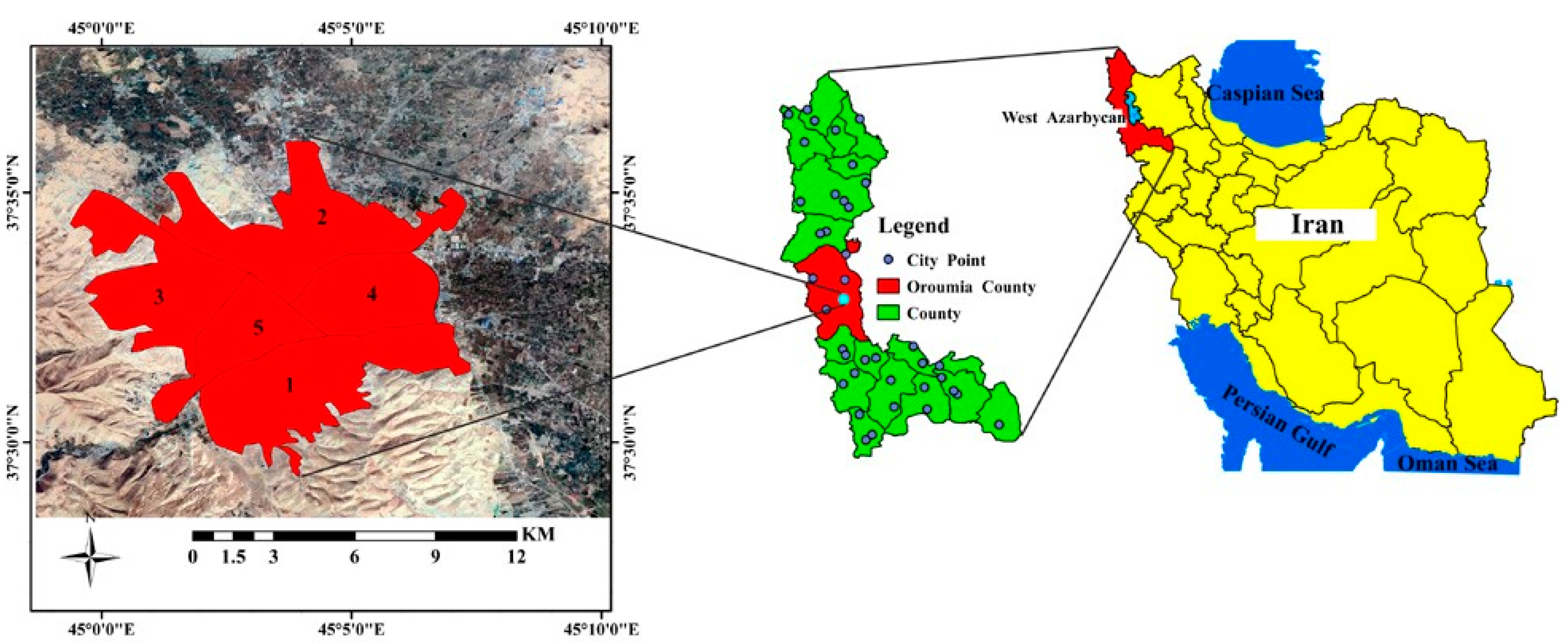
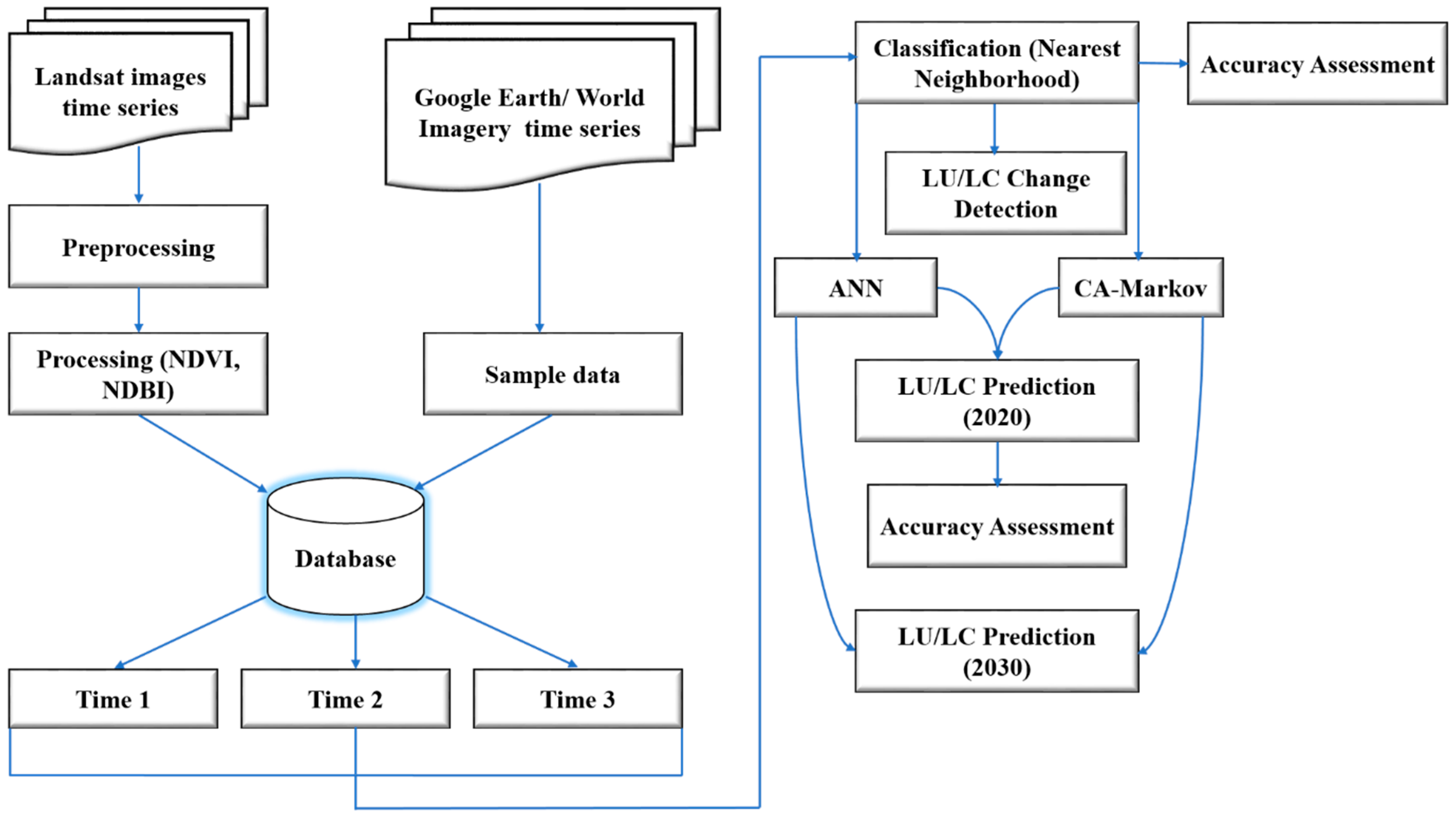
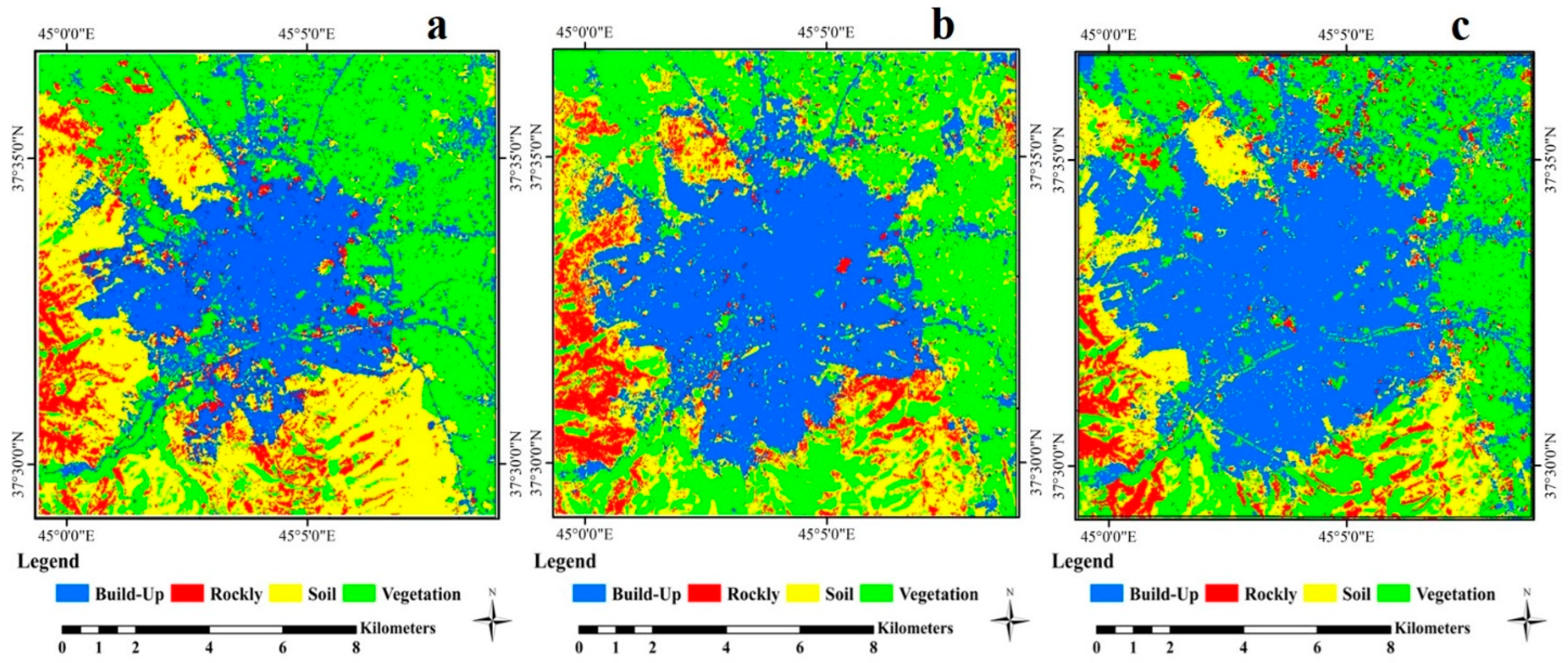
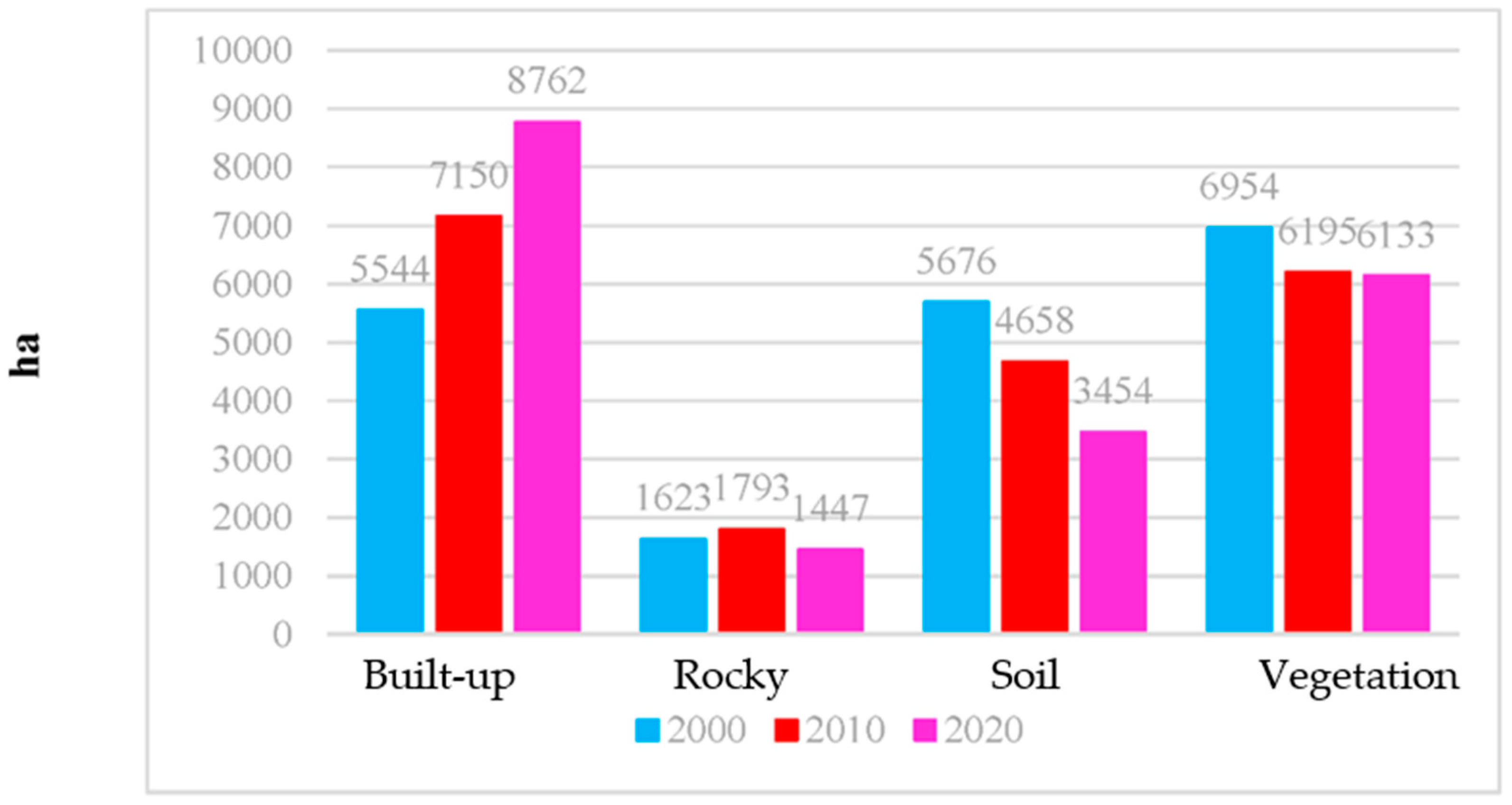
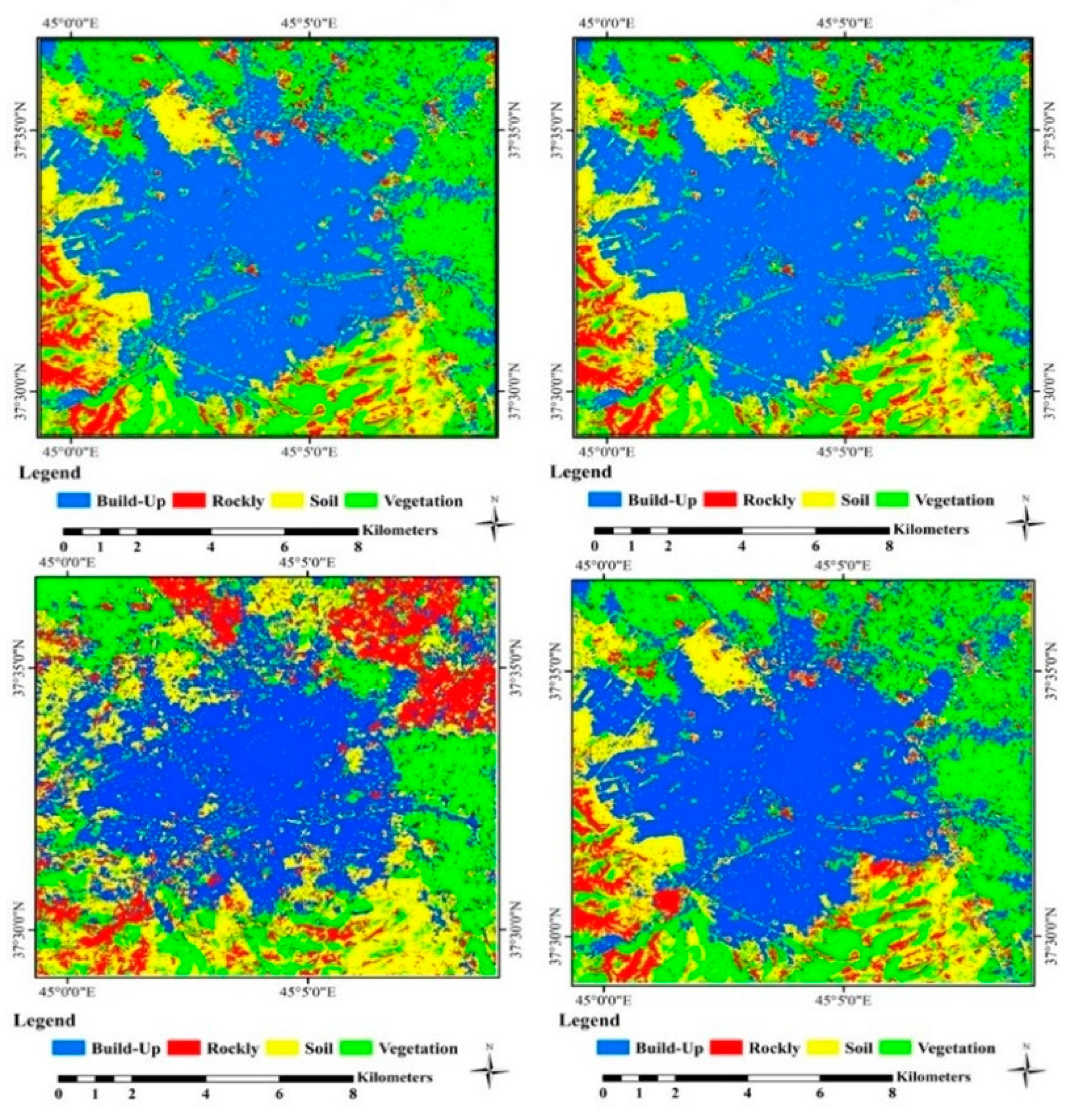
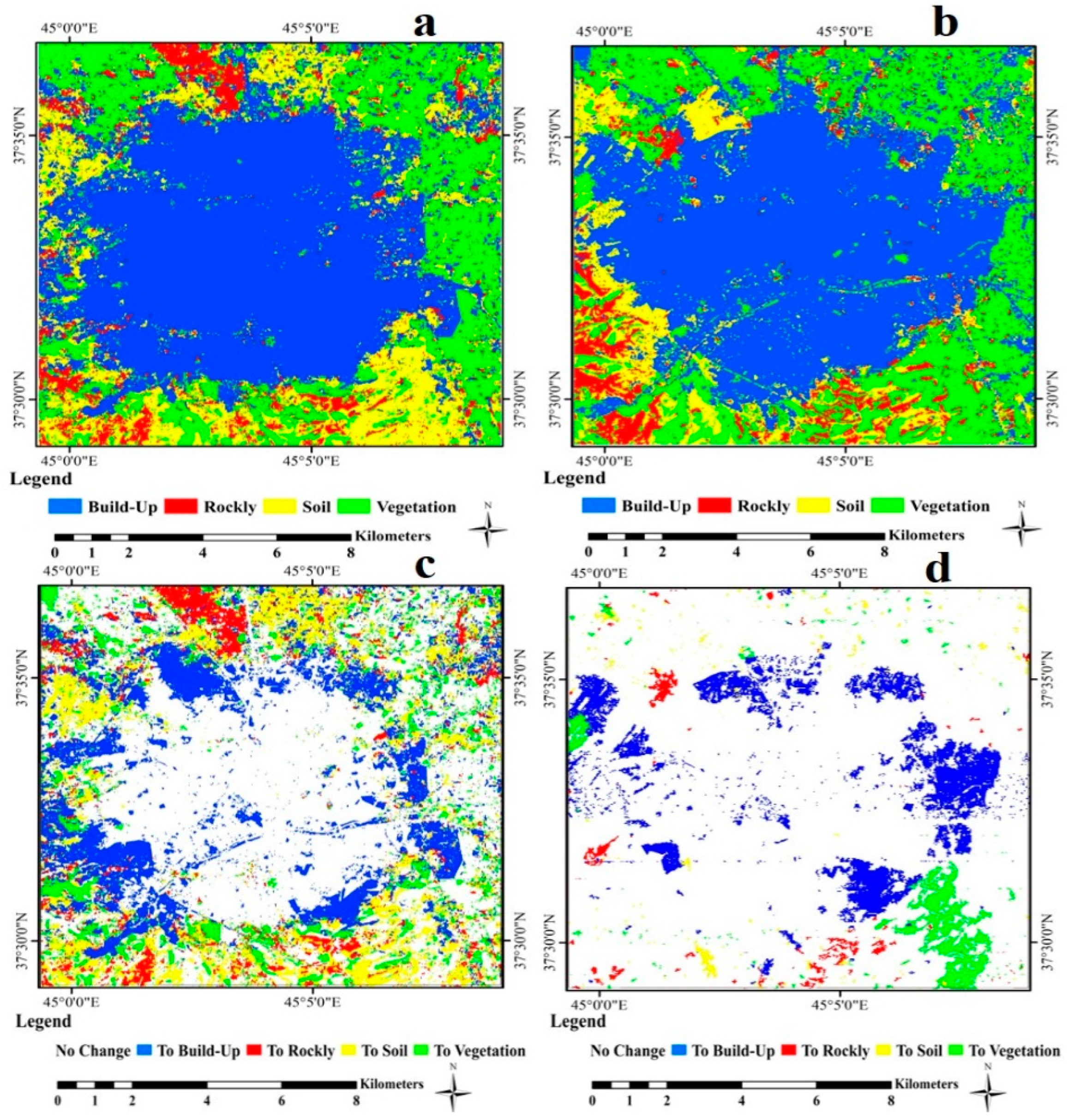
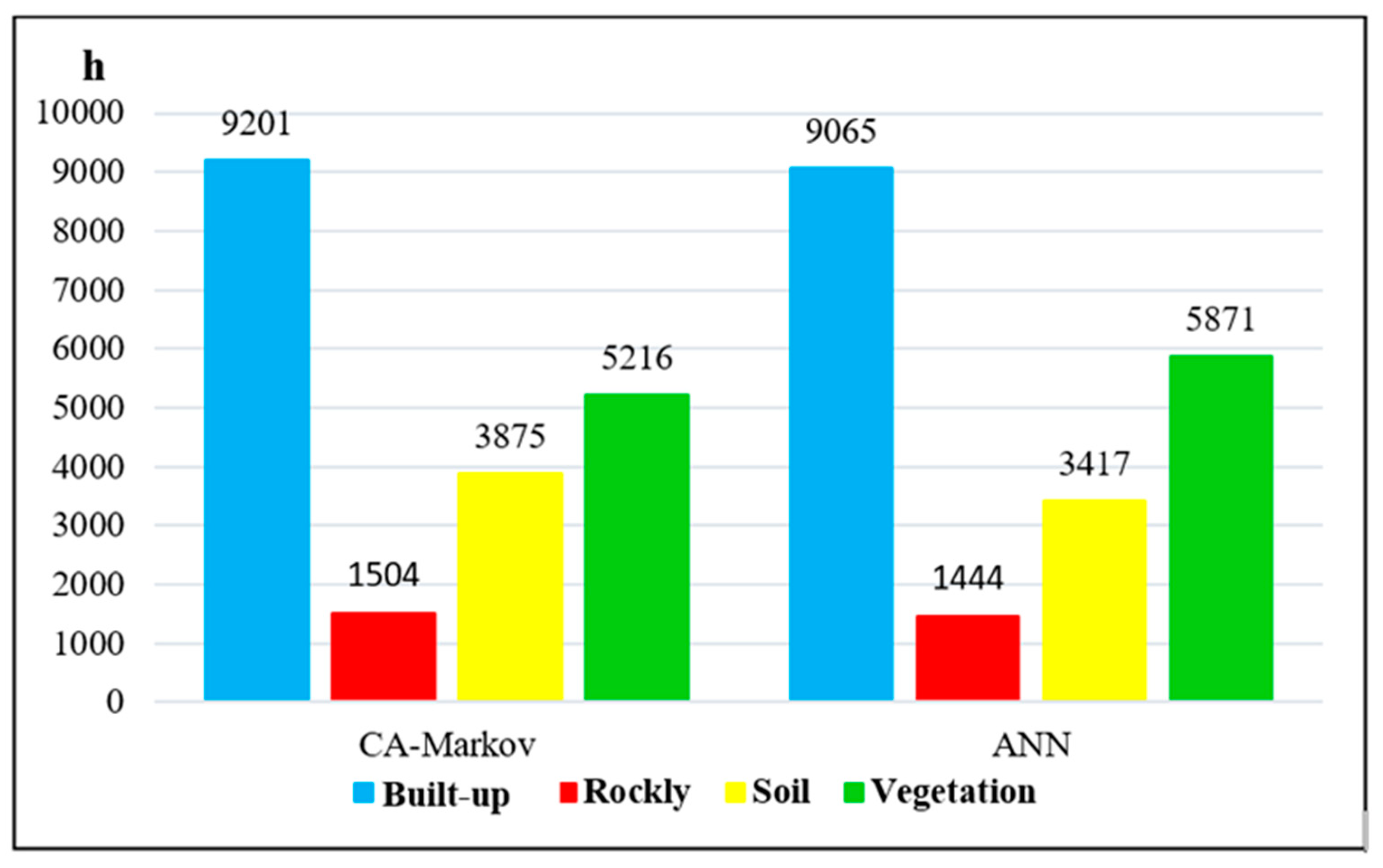
| Sample Point Size (Pixel) | ||||
|---|---|---|---|---|
| Year | Build-Up | Rocky | Soil | Vegetation |
| 2000 | 2514 | 941 | 1542 | 3564 |
| 2010 | 2968 | 913 | 1317 | 3098 |
| 2020 | 3311 | 1072 | 1298 | 3012 |
| Years | Accuracy Assessment | |||||
|---|---|---|---|---|---|---|
| Built-Up | Rocky | Soil | Vegetation | Average | Kappa Coefficient | |
| 2000 | 94.36 | 96.13 | 83.59 | 99.72 | 93.63 | 91.49 |
| 2010 | 98.48 | 96.88 | 83.18 | 99.79 | 94.58 | 92.48 |
| 2020 | 99.51 | 99.42 | 97.91 | 99.51 | 99.21 | 98.94 |
| Algorithm | Validation Method | LULC | ||||
|---|---|---|---|---|---|---|
| Built-Up | Rocky | Soil | Vegetation | Average | ||
| CA–Markov | Completeness | 96.34% | 98.11% | 91.13% | 98.79% | 96.09% |
| Correctness | 97.36% | 91.77% | 98.28% | 98.47% | 96.47% | |
| Quality | 93.99% | 89.89% | 94.63% | 96.16% | 93.67% | |
| ANN | Completeness | 95.63% | 95.23% | 95.77% | 98.18% | 96.21% |
| Correctness | 98.06% | 95.31% | 96.29% | 95.62% | 96.32% | |
| Quality | 93.85% | 92.11% | 94.79% | 94.44% | 93.8% | |
Publisher’s Note: MDPI stays neutral with regard to jurisdictional claims in published maps and institutional affiliations. |
© 2022 by the authors. Licensee MDPI, Basel, Switzerland. This article is an open access article distributed under the terms and conditions of the Creative Commons Attribution (CC BY) license (https://creativecommons.org/licenses/by/4.0/).
Share and Cite
Asadi, M.; Oshnooei-Nooshabadi, A.; Saleh, S.-S.; Habibnezhad, F.; Sarafraz-Asbagh, S.; Van Genderen, J.L. Urban Sprawl Simulation Mapping of Urmia (Iran) by Comparison of Cellular Automata–Markov Chain and Artificial Neural Network (ANN) Modeling Approach. Sustainability 2022, 14, 15625. https://doi.org/10.3390/su142315625
Asadi M, Oshnooei-Nooshabadi A, Saleh S-S, Habibnezhad F, Sarafraz-Asbagh S, Van Genderen JL. Urban Sprawl Simulation Mapping of Urmia (Iran) by Comparison of Cellular Automata–Markov Chain and Artificial Neural Network (ANN) Modeling Approach. Sustainability. 2022; 14(23):15625. https://doi.org/10.3390/su142315625
Chicago/Turabian StyleAsadi, Milad, Amir Oshnooei-Nooshabadi, Samira-Sadat Saleh, Fattaneh Habibnezhad, Sonia Sarafraz-Asbagh, and John Lodewijk Van Genderen. 2022. "Urban Sprawl Simulation Mapping of Urmia (Iran) by Comparison of Cellular Automata–Markov Chain and Artificial Neural Network (ANN) Modeling Approach" Sustainability 14, no. 23: 15625. https://doi.org/10.3390/su142315625
APA StyleAsadi, M., Oshnooei-Nooshabadi, A., Saleh, S.-S., Habibnezhad, F., Sarafraz-Asbagh, S., & Van Genderen, J. L. (2022). Urban Sprawl Simulation Mapping of Urmia (Iran) by Comparison of Cellular Automata–Markov Chain and Artificial Neural Network (ANN) Modeling Approach. Sustainability, 14(23), 15625. https://doi.org/10.3390/su142315625






